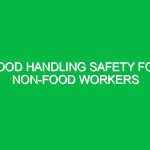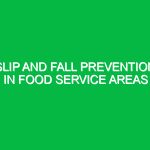In the bustling environment of a kitchen, where knives chop and pans sizzle, the risk of cuts and lacerations looms large. Preventing cuts and lacerations in kitchens is not merely a best practice; it is a critical aspect of Health, Safety, and Environment (HSE) management. These injuries can lead to significant downtime, hefty medical bills, and even legal ramifications for employers. Thus, understanding the hazards, risks, and preventive measures associated with kitchen work is paramount for both employees and employers alike.
The Relevance of Preventing Cuts and Lacerations in Kitchens
Every year, countless kitchen workers sustain injuries due to cuts and lacerations. These incidents not only disrupt the workflow but also raise concerns regarding employee wellbeing and compliance with safety regulations. For instance, in a recent survey conducted by the National Safety Council, nearly 30% of kitchen staff reported being injured while on the job, with cuts being the most common injury. Such statistics underscore the necessity of implementing robust safety measures to mitigate these risks.
Understanding Hazards and Risks in Kitchen Settings
When delving into the realm of preventing cuts and lacerations in kitchens, one must first identify the prevalent hazards. The kitchen environment is rife with potential dangers, including:
1. Sharp Tools and Equipment
Knives, slicers, and other cutting instruments are indispensable in any kitchen. However, their very nature poses a significant risk. A simple slip while chopping vegetables can lead to deep cuts that may require stitches. The importance of ensuring that these tools are well-maintained and used correctly cannot be overstated.
2. Wet and Slippery Surfaces
Kitchens often have spills and splashes that create slippery surfaces. A worker who loses their footing may inadvertently drop a knife, resulting in injuries to themselves or others. Maintaining dry floors is crucial in avoiding such accidents.
3. Lack of Adequate Training
In many kitchens, employees may not receive proper training on how to use equipment safely. This oversight can lead to misuse and consequently, injuries. A comprehensive training program is essential for fostering a safety-conscious culture.
4. Distraction and Multitasking
In a high-pressure kitchen environment, distractions are common. Chefs and kitchen staff often juggle multiple tasks at once, which can lead to lapses in attention and increase the likelihood of accidents. Recognizing the importance of focused work is vital in minimizing risks.
Detailed Safety Precautions and Best Practices
With a clearer understanding of the hazards, it is time to explore actionable safety precautions that can significantly reduce the risk of cuts and lacerations in kitchens.
1. Proper Tool Maintenance
Keeping knives and cutting tools sharp is essential. While it may seem counterintuitive, a sharp knife is safer than a dull one. Dull knives require more force to cut through food, increasing the likelihood of slipping and causing injuries. Regular sharpening and maintenance of tools not only enhance efficiency but also reduce the risk of accidents.
2. Use of Personal Protective Equipment (PPE)
Wearing appropriate PPE is a critical component of kitchen safety. Cut-resistant gloves, for example, can provide an additional layer of protection when handling sharp objects. Non-slip shoes are also essential to prevent slips and falls on wet surfaces. Employers should ensure that all kitchen staff are equipped with and trained to use necessary PPE.
3. Training and Education
Implementing a comprehensive training program focused on safety procedures is vital. New employees should undergo an orientation that covers the safe handling of kitchen tools, the importance of maintaining a clean workspace, and emergency procedures in case of an injury. Ongoing training sessions can reinforce these practices and keep safety at the forefront of daily operations.
4. Establishing Clear Work Zones
Creating designated work zones can help minimize distractions and streamline kitchen operations. When each staff member has a specific area to work in, the chances of accidental injuries from bumping into one another or reaching for tools can be greatly reduced. Clear communication about work zones ensures that everyone is aware of their surroundings.
5. Implementing Good Housekeeping Practices
Regular cleaning and maintenance of kitchen areas are essential for reducing hazards. Spills should be cleaned up immediately, and clutter should be minimized. A clean kitchen not only promotes safety but also enhances overall efficiency. Encourage workers to take responsibility for their workspaces, fostering a culture of cleanliness and safety.
6. Encouraging a Culture of Safety
Promoting a culture of safety within the kitchen can significantly impact the frequency of injuries. Encourage staff to report near misses or unsafe conditions without fear of reprimand. Open communication about safety concerns can lead to improvements in practices and a stronger commitment to preventing injuries.
Regulations and Standards Governing Kitchen Safety
Various regulations and standards govern safety practices in kitchens, ensuring that employers maintain a safe working environment. The Occupational Safety and Health Administration (OSHA) provides guidelines on workplace safety, including the proper use of tools and equipment. Compliance with these regulations is not optional; it is a legal requirement that protects both employees and employers.
1. Hazard Communication Standard
The Hazard Communication Standard (HCS) mandates that employers inform employees about the hazards associated with the chemicals and tools they use. This includes providing Material Safety Data Sheets (MSDS) for hazardous substances and ensuring that all staff are trained in recognizing and mitigating risks.
2. General Duty Clause
The General Duty Clause requires employers to provide a workplace free from recognized hazards that could cause death or serious harm. This clause emphasizes the responsibility of employers to proactively address safety concerns and implement necessary precautions.
3. Industry-Specific Standards
In addition to federal regulations, many states have their own safety standards and regulations tailored to the food service industry. Familiarizing oneself with local laws and ensuring compliance is crucial for maintaining a safe kitchen environment.
Conclusion
Preventing cuts and lacerations in kitchens is a multifaceted endeavor that requires commitment from both employers and employees. By understanding the hazards, implementing effective safety measures, and adhering to regulatory standards, kitchens can become safer environments for all. The path to safety is paved with awareness, education, and a collective commitment to fostering a culture that prioritizes wellbeing. By taking these steps, we can significantly reduce the incidence of injuries and create a more productive, efficient, and safe kitchen atmosphere.


